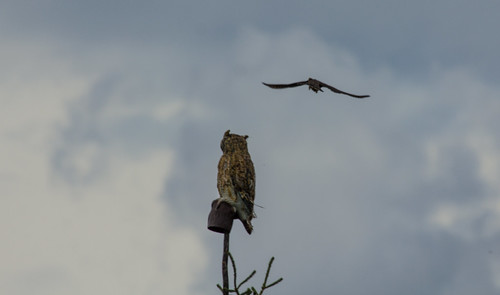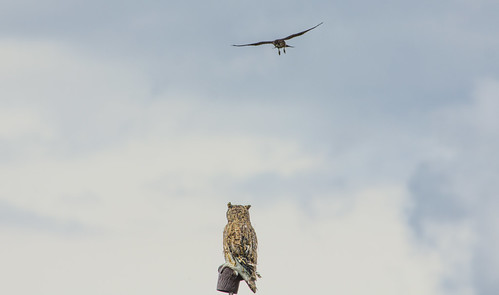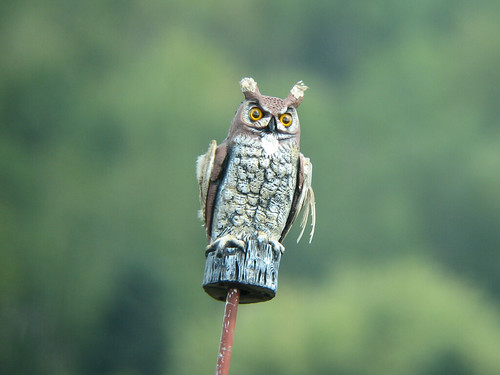When new visitors come up to Hawk Ridge in Duluth, they’re often mystified by the two owl decoys set on poles near the counter’s platform. Our researchers affix a few actual bird feathers to them, making them look more realistic than most fake owls.
Owls are natural enemies of hawks and falcons. I've heard people explain that owls eat hawk eggs, but that's simply not true. Owls can't carry smooth, slippery eggs in their talons--they'd drop or puncture them. And if they tried to swallow an egg right there in the nest, their sharp mandibles would puncture it, leaking the goopy contents onto their face. No, when owls attack nesting hawks, they're aiming for the chicks or the parent. The Cornell Lab of Ornithology's nest cam once caught video of a Great Horned Owl attacking an incubating female Great Blue Heron. The owl certainly could not have carried her off, but could tear chunks of meat off in place, to eat herself or to carry to her own young. Great Horned Owls were the primary cause of mortality for young but full-sized Peregrine Falcons during the reintroduction programs in Minnesota. Most hawks are fairly helpless in the dark, but that doesn’t mean the hawks can’t do anything to defend themselves—if they spot a Great Horned Owl during the day, they do their best to chase it off, lowering the chances that the owl will observe their roosting place.
 |
| Here comes the Merlin! |
The hawks and falcons passing along Hawk Ridge are migrating through, and most Great Horned Owls are rather sedentary, so hawks moving through an area don’t really have to worry about owls they pass over. Indeed, almost all the raptors flying along the Ridge ignore the decoys, but every now and then a hawk, usually a Sharp-shin or Merlin, dive-bombs one of them, giving our visitors a thrilling look. For some reason, Merlins very often repeat the attack more than a few times. They’re not stupid—they figure out soon enough that it’s a fake, but I like to think they get even angrier when they realize the decoy tricked them.
 |
| Makes another pass. |
When my friend Lisa and I were up at Hawk Ridge on September 2, we watched a slow but steady stream of migrating raptors and occasional flocks of waxwings. Suddenly, two Merlins appeared, flying right past the owl decoys, and suddenly both of them wheeled around and started attacking. Merlins are wonderfully powerful little falcons—not much bigger in outward appearance than kestrels—the American Kestrel averages 10 inches long with a 22 inch wingspan, while the Merlin is about the same length with a 23 ½ inch wingspan—yet the kestrel averages only about 4 ounces while the Merlin averages almost double—about 7 ounces.
That added weight is all muscle—Pete Dunne often describes the difference between a Merlin and a kestrel as the difference between a Harley Davidson and a scooter. And these powerhouses are speedy, too, so it was tricky tracking them with my camera. I got a few photos by focusing on the owl and waiting till I saw a Merlin fly in. I was glad to get any photos at all, even though none of them turned out very well. After several passes at both decoys, the Merlins moved on, but something must have stuck in their craw because all of a sudden they were back, in full attack mode. The whole encounter lasted more than 5 minutes. I hate hearing Merlins calling in my own yard—I'm scared they're targeting my chickadees. But there's no tragedy in store for anyone when Merlins are dive-bombing a fake owl, so watching that is pure pleasure.
 |
| Merlin making a final pass |
